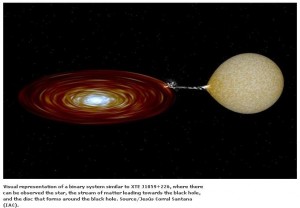Black Hole More Than Five Times Greater In Mass Than Sun Discovered
They sensed it, but hadn’t been able to confirm it until now. Researchers from the Instituto de Astrofísica de Canarias (IAC) have discovered the existence of a black hole 5.4 times greater in mass than that of our Sun, located in the X-ray binary system XTE J1859+226. The observations carried out from the Gran Telescopio Canarias (GTC), managing to obtain the first spectroscopic data from this binary system to be published, have been determinant for the discovery.
X-ray binaries are stellar systems composed by a compact object (which may be a neutron star or a black hole) and a ‘normal’ star. The compact object sucks matter out of the star and adds it slowly to its own mass, through a spiral disc formed around it. This process of absorption is known as acretion. Only 20 binary systems, out of an estimated population of around 5,000 within our Galaxy, are known to contain a black hole.
XTE J1859+226 is, in particular, a transient X-ray binary located in the Vulpecula constellation. It was discovered by satellite RXTE during an eruption registered in 1999.

“Transient X-ray binaries are characterised for spending most of their life in a state of calmness, but occasionally entering eruption stages, during which the rhythm of acretion of matter toward the black hole is triggered”, Jesús Corral Santana explains, an astrophysicist from the IAC, who leads the work published in the Monthly Notices of the Royal Astronomical Society (MNRAS).
Neutron stars as well as black holes are the remains left by a massive star after its death. Most of the known neutron stars have a mass around 1.4 times that of the Sun, though in some cases, values up to over twice the mass of the Sun have been measured. Astronomers believe that when greater than tree times the solar mass, neutron stars are not stable, and end up collapsing and forming a black hole.
For Corral-Santana, “measuring the mass of compact objects is essential to determine what kind of object it may be. If it’s greater than three times the solar mass, it can only be a black hole. We found that XTE J1859+226 has a black hole more than 5.4 times greater than the mass of the Sun. It’s the definitive confirmation of the existence of a black hole in this object”.
“With this result we add a new piece to the study of the mass distribution of black holes. The shape of this distribution has very important implications for our knowledge about the death of massive stars, the formation of black holes, and the evolution of X-ray binary systems”, the IAC astrophysicist adds.
Twelve years of observation: measuring the visible and the invisible
The astrophysicists’ team at IAC hadn’t lost track of the stellar object since it entered an eruption stage in 1999, when they started to set up observation campaigns to follow its evolution. The researchers have combined the photometric measures from the Isaac Newton Telescope (INT) and the William Herschel Telescope (WHT) in year 2000, and those from the Nordic Optical Telescope (NOT) in 2008, with the spectroscopy carried out with the GTC in 2010, the first one ever published about this particular object.
“Due to the low brilliance of the system under observation, we needed 10 meter telescopes in able to obtain spectra. In this sense, having been able to make our observations from the GTC has been determinant”, Corral-Santana emphasises.
The measurements at the GTC were carried out with the OSIRIS instrument, which may be used as a camera or as a spectrograph in the visible range. The spectrograph decomposes the light emitted by a star into its different frequencies and allows detecting lines corresponding to the different chemical elements present in its atmosphere. These lines adduce information about the physical properties of the star and its movement.
The photometric measures allowed determining the orbital period of the binary (6.6 hours), while the spectroscopy data also provided information about the speed of the star’s orbital movement around the black hole. The combination of both of these parameters proved to be vital to calculate the mass of the back hole.
The Gran Telescopio Canarias (GTC), located at the Roque de los Muchachos Observatory (in La Palma, Canary Islands), is the biggest optical-infrared telescope of the World, with a 10.4 metre diameter mirror.
